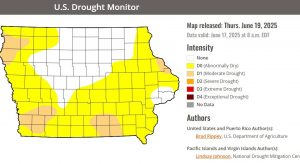Dry conditions are lessening, but most of Iowa still needs rain
June 20th, 2025 by Ric Hanson
(Radio Iowa) – Recent rainstorms are helping to improve Iowa’s soil conditions, though only about a third of the state is completely drought-free. The new map from the U-S Drought Monitor shows the amount of the state in abnormally dry or drought conditions has fallen in the past week from around 80 to just under 70 percent. State climatologist Justin Glisan says southwest Iowa remains a “problem child” with above average temperatures and below average rainfall.
“One of the driest parts of the state has been that southwest corner of Iowa,” Glisan says. “As we shifted into May, we did see a slightly more active weather pattern, but actually it was the first May since 2010 without a tornado reported. So, the lack of severe weather — that’s where we see drought and dryness across the state.” While spring officially ends later today (Friday), Glisan says meteorological summer started June 1st. Over the course of March, April and May, he says Iowa was two-and-a-half degrees warmer than normal, and two inches below normal for precipitation. Though Iowa broke a four-year drought in May of last year, Glisan says dry conditions are still impacting water levels. 
“If you go back four to five years, most stations across the state are still missing out on about a year’s worth of precipitation,” he says. “So, this has impacts on aquifers, which we pull water out of, but also well fields and other water supply sources.” The new drought monitor map shows pockets of “moderate” drought in all four corners of the state. As corn pollination and detassling season approaches, Glisan says Iowa’s crops may become stressed.
“With those windy conditions and high temperatures, that’s where we can exacerbate dryness across the surface,” Glisan says. “So, we’re extracting soil moisture — that topsoil moisture — first. Plus, vegetative demand is increasing with corn and beans, as well. So, this is where we can get into a period of time of rapid drying at the surface.”
Glisan says that could cause stress in corn and soybean fields. On the positive side, he says most of the state remains in a lull in terms of severe weather.


